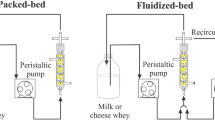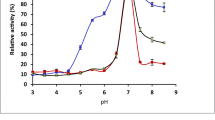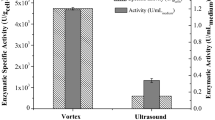Abstract
The aim of this study was to evaluate the catalytic characteristics and operational stability of the tetrameric Kluyveromyces lactis β-galactosidase (KLG) enzyme immobilized on collagen. The support was submitted to four different treatments: aluminum, glutaraldehyde, acetic acid, and a combination of the methods with aluminum and glutaraldehyde. The four modified supports and the enzyme, both in its soluble and immobilized forms, were studied using thermogravimetric, differential exploratory calorimetry, infrared spectroscopy, and textural analyses. Operational pH, temperature and kinetic parameters of the soluble enzyme and of derivatives were characterized. Immobilized enzyme was applied in milk and whey lactose hydrolysis, via batch and continuous processing. There was no significant reduction (p < 0.05) in immobilization yields of all derivatives with loads up to 100 mgprotein/gsupport, with yields of approximately 70%. All derivatives reached a percentage of approximately 50% of lactose hydrolysis after 17 reuse cycles in the hydrolysis of milk and whey, using batch processing. On the other hand, hydrolysis percentages higher than 50% were achieved with packed-bed reactor even after 48 h of operation. Immobilized KLG on collagen maintained its catalytic characteristics and showed good operational stability in hydrolysis processes, especially in the continuous processes with packed-bed reactor.




Similar content being viewed by others
References
Urrutia P, Bernal C, Wilson L, Illanes A (2018) Use of chitosan heterofunctionality for enzyme immobilization: β-galactosidase immobilization for galacto-oligosaccharide synthesis. Int J Biol Macromol 116:182–193. https://doi.org/10.1016/j.ijbiomac.2018.04.112
Pereira-Rodríguez Á, Fernández-Leiro R, González-Siso MI et al (2012) Structural basis of specificity in tetrameric Kluyveromyces lactis β-galactosidase. J Struct Biol 177:392–401. https://doi.org/10.1016/j.jsb.2011.11.031
Zhang Z, Zhang R, Chen L, McClements DJ (2016) Encapsulation of lactase (β-galactosidase) into κ-carrageenan-based hydrogel beads: impact of environmental conditions on enzyme activity. Food Chem 200:69–75. https://doi.org/10.1016/j.foodchem.2016.01.014
Silvério SC, Macedo EA, Teixeira JA, Rodrigues LR (2018) New β-galactosidase producers with potential for prebiotic synthesis. Bioresour Technol 250:131–139. https://doi.org/10.1016/j.biortech.2017.11.045
Alikkunju AP, Sainjan N, Silvester R et al (2016) Screening and characterization of cold-active β-galactosidase producing psychrotrophic enterobacter ludwigii from the sediments of Arctic Fjord. Appl Biochem Biotechnol 180:477–490. https://doi.org/10.1007/s12010-016-2111-y
Illanés A (2011) Whey upgrading by enzyme biocatalysis. Electron J Biotechnol 14:1–29. https://doi.org/10.2225/vol14-issue6-fulltext-11
Voget CE (2018) Recovery of ß-galactosidase from the yeast Kluyveromyces lactis by cell permeabilization with sarkosyl. Process Biochem 75:250–256. https://doi.org/10.1016/j.procbio.2018.06.020
López-Gallego F, Betancor L, Mateo C et al (2005) Enzyme stabilization by glutaraldehyde crosslinking of adsorbed proteins on aminated supports. J Biotechnol 119:70–75. https://doi.org/10.1016/j.jbiotec.2005.05.021
Grosová Z, Rosenberg M, Rebroš M (2008) Perspectives and applications of immobilised β-galactosidase in food industry—a review. Czech J Food Sci 26:1–14
Pečar D, Goršek A (2017) Process and kinetic characteristics of glucose oxidation catalyzed with immobilized enzyme. React Kinet Mech Catal 122:43–51. https://doi.org/10.1007/s11144-017-1202-2
Hu Y, Dai L, Liu D et al (2018) Progress & prospect of metal-organic frameworks (MOFs) for enzyme immobilization (enzyme/MOFs). Renew Sustain Energy Rev 91:793–801. https://doi.org/10.1016/j.rser.2018.04.103
Zaak H, Sassi M, Fernandez-Lafuente R (2018) A new heterofunctional amino-vinyl sulfone support to immobilize enzymes: application to the stabilization of β-galactosidase from Aspergillus oryzae. Process Biochem 64:200–205. https://doi.org/10.1016/j.procbio.2017.09.020
Fernandez-Lopez L, Pedrero SG, Lopez-Carrobles N et al (2017) Effect of protein load on stability of immobilized enzymes. Enzyme Microb Technol 98:18–25. https://doi.org/10.1016/j.enzmictec.2016.12.002
Bernal C, Rodríguez K, Martínez R (2018) Integrating enzyme immobilization and protein engineering: an alternative path for the development of novel and improved industrial biocatalysts. Biotechnol Adv 36:1470–1480. https://doi.org/10.1016/j.biotechadv.2018.06.002
Amin HA, Secundo F, Amer H et al (2018) Improvement of Aspergillus flavus saponin hydrolase thermal stability and productivity via immobilization on a novel carrier based on sugarcane bagasse. Biotechnol Rep 17:55–62. https://doi.org/10.1016/j.btre.2017.12.007
Naghdi M, Taheran M, Brar SK et al (2018) Pinewood nanobiochar: a unique carrier for the immobilization of crude laccase by covalent bonding. Int J Biol Macromol 115:563–571. https://doi.org/10.1016/j.ijbiomac.2018.04.105
Kessi E, Arias JL (2019) Using natural waste material as a matrix for the immobilization of enzymes: chicken eggshell membrane powder for β-galactosidase immobilization. Appl Biochem Biotechnol 187:101–115. https://doi.org/10.1007/s12010-018-2805-4
Song N, Chen S, Huang X et al (2011) Immobilization of catalase by using Zr(IV)-modified collagen fiber as the supporting matrix. Process Biochem 46:2187–2193. https://doi.org/10.1016/j.procbio.2011.09.001
Silver FH, Jaffe M, Shah RG (2018) Structure and behavior of collagen fibers. Handbook of properties of textile and technical fibres. Woodhead Publishing, Sawston, pp 345–365
Lu AX, Liao XP, Zhou RQ, Shi B (2007) Preparation of Fe(III)-immobilized collagen fiber for lysozyme adsorption. Colloids Surf A 301:85–93. https://doi.org/10.1016/j.colsurfa.2006.12.027
Gennari A, Mobayed FH, Volpato G, de Souza CFV (2018) Chelation by collagen in the immobilization of Aspergillus oryzae β-galactosidase: a potential biocatalyst to hydrolyze lactose by batch processes. Int J Biol Macromol. https://doi.org/10.1016/j.ijbiomac.2017.12.088
Ellenrieder G, Daz M (1996) Thermostabilization of naringinase from Penicillium decumbens by proteins in solution and immobilization on insoluble proteins. Biocatal Biotransform 14:113–123. https://doi.org/10.3109/10242429609106880
Fernandez-Lafuente R (2009) Stabilization of multimeric enzymes: strategies to prevent subunit dissociation. Enzyme Microb Technol 45:405–418. https://doi.org/10.1016/j.enzmictec.2009.08.009
Orrego AH, Trobo-Maseda L, Rocha-Martin J, Guisan JM (2017) Immobilization-stabilization of a complex multimeric sucrose synthase from Nitrosomonas europaea synthesis of UDP-glucose. Enzyme Microb Technol 105:51–58. https://doi.org/10.1016/j.enzmictec.2017.06.008
Bradford MM (1976) A rapid and sensitive method for the quantitation of microgram quantities of protein utilizing the principle of protein-dye binding. Anal Biochem 72:248–254. https://doi.org/10.1016/0003-2697(76)90527-3
Mariotti MP, Yamanaka H, Araujo AR, Trevisan HC (2008) Hydrolysis of whey lactose by immobilized β-galactosidase. Braz Arch Biol Technol 51:1233–1240. https://doi.org/10.1590/S1516-89132008000600019
Sheldon RA, van Pelt S (2013) Enzyme immobilisation in biocatalysis: why, what and how. Chem Soc Rev 42:6223–6235. https://doi.org/10.1039/C3CS60075K
Webb PA, Orr C (1997) Analytical methods in fine particle technology. Micromeritics Instrument Corporation, Norcross
Lente G (2015) Deterministic kinetics in chemistry and systems biology: the dynamics of complex reaction networks. Springer, Cham
Wang F, Guo C, Liu H-Z, Liu C-Z (2008) Immobilization of Pycnoporus sanguineus laccase by metal affinity adsorption on magnetic chelator particles. J Chem Technol Biotechnol 83:97–104. https://doi.org/10.1002/jctb
Liao X, Zhang M, Shi B (2004) Collagen-fiber-immobilized tannins and their adsorption of Au(III). Ind Eng Chem Res 43:2222–2227. https://doi.org/10.1021/ie0495877
Križnik L, Vasić K, Knez Ž, Leitgeb M (2018) Hyper-activation of ß-galactosidase from Aspergillus oryzae via immobilization onto amino-silane and chitosan magnetic maghemite nanoparticles. J Clean Prod 179:225–234. https://doi.org/10.1016/j.jclepro.2018.01.117
Suárez S, Guerrero C, Vera C, Illanes A (2018) Effect of particle size and enzyme load on the simultaneous reactions of lactose hydrolysis and transgalactosylation with glyoxyl-agarose immobilized β-galactosidase from Aspergillus oryzae. Process Biochem 73:56–64. https://doi.org/10.1016/j.procbio.2018.08.016
Mitra T, Sailakshmi G, Gnanamani A, Mandal AB (2013) Studies on cross-linking of succinic acid with chitosan/collagen. Mater Res 16:755–765. https://doi.org/10.1590/S1516-14392013005000059
Fernandes LL, Resende CX, Tavares DS et al (2011) Cytocompatibility of chitosan and collagen-chitosan scaffolds for tissue engineering. Polímeros 21:1–6. https://doi.org/10.1590/S0104-14282011005000008
Kittur FS, Harish Prashanth KV, Udaya Sankar K, Tharanathan RN (2002) Characterization of chitin, chitosan and their carboxymethyl derivatives by differential scanning calorimetry. Carbohydr Polym 49:185–193. https://doi.org/10.1016/S0144-8617(01)00320-4
Ku CS, Sathishkumar M, Mun SP (2007) Binding affinity of proanthocyanidin from waste Pinus radiata bark onto proline-rich bovine achilles tendon collagen type I. Chemosphere 67:1618–1627. https://doi.org/10.1016/j.chemosphere.2006.11.037
Genari AN, Passos FV, Passos FML (2003) Configuration of a bioreactor for milk lactose hydrolysis. J Dairy Sci 86:2783–2789. https://doi.org/10.3168/jds.S0022-0302(03)73875-2
Ansari SA, Husain Q (2012) Lactose hydrolysis from milk/whey in batch and continuous processes by concanavalin A-Celite 545 immobilized Aspergillus oryzae β galactosidase. Food Bioprod Process 90:351–359. https://doi.org/10.1016/j.fbp.2011.07.003
Elnashar MMM, Yassin MA (2009) Lactose hydrolysis by β-galactosidase covalently immobilized to thermally stable biopolymers. Appl Biochem Biotechnol 159:426–437. https://doi.org/10.1007/s12010-008-8453-3
Ansari SA, Satar R, Chibber S, Khan MJ (2013) Enhanced stability of Kluyveromyces lactis β galactosidase immobilized on glutaraldehyde modified multiwalled carbon nanotubes. J Mol Catal B Enzym 97:258–263. https://doi.org/10.1016/j.molcatb.2013.09.008
Jiang H, Zou H, Wang H et al (2000) On-line characterization of the activity and reaction kinetics of immobilized enzyme by high-performance frontal analysis. J Chromatogr A 903:77–84. https://doi.org/10.1016/S0021-9673(00)00846-3
Maugard T, Gaunt D, Legoy MD, Besson T (2003) Microwave-assisted synthesis of galacto-oligosaccharides from lactose with immobilized β-galactosidase from Kluyveromyces lactis. Biotechnol Lett 25:623–629. https://doi.org/10.1023/A:1023060030558
Bayramoglu G, Tunali Y, Arica MY (2007) Immobilization of β-galactosidase onto magnetic poly(GMA-MMA) beads for hydrolysis of lactose in bed reactor. Catal Commun 8:1094–1101. https://doi.org/10.1016/j.catcom.2006.10.029
Souza CJF, Garcia-rojas EE, Souza CSF et al (2019) Immobilization of β-galactosidase by complexation: effect of interaction on the properties of the enzyme. Int J Biol Macromol 122:594–602. https://doi.org/10.1016/j.ijbiomac.2018.11.007
Güleç HA (2013) Immobilization of β-galactosidase from Kluyveromyces lactis onto polymeric membrane surfaces: effect of surface characteristics. Colloids Surf B 104:83–90. https://doi.org/10.1016/j.colsurfb.2012.11.039
Shen Q, Yang R, Hua X et al (2011) Gelatin-templated biomimetic calcification for β-galactosidase immobilization. Process Biochem 46:1565–1571. https://doi.org/10.1016/j.procbio.2011.04.010
Fischer J, Guidini CZ, Santana LNS et al (2013) Optimization and modeling of lactose hydrolysis in a packed bed system using immobilized β-galactosidase from Aspergillus oryzae. J Mol Catal B 85–86:178–186. https://doi.org/10.1016/j.molcatb.2012.09.008
Klein MP, Fallavena LP, Schöffer JDN et al (2013) High stability of immobilized β-d-galactosidase for lactose hydrolysis and galactooligosaccharides synthesis. Carbohydr Polym 95:465–470. https://doi.org/10.1016/j.carbpol.2013.02.044
Aknowledgements
We would like to thank Conselho Nacional de Desenvolvimento Científico e Tecnológico (CNPq) and Fundação de Amparo à Pesquisa do Estado do Rio Grande do Sul (FAPERGS) for the scholarships, and Universidade do Vale do Taquari - Univates for the financial support granted for this research paper. This study was financed in part by the Coordenação de Aperfeiçoamento de Pessoal de Nível Superior - Brasil (CAPES) - Finance Code 001.
Author information
Authors and Affiliations
Corresponding author
Ethics declarations
Conflict of interest
The authors declare they do not have any conflict of interest.
Additional information
Publisher's Note
Springer Nature remains neutral with regard to jurisdictional claims in published maps and institutional affiliations.
Rights and permissions
About this article
Cite this article
Gennari, A., Mobayed, F.H., Catto, A.L. et al. Kluyveromyces lactis β-galactosidase immobilized on collagen: catalytic stability on batch and packed-bed reactor hydrolysis. Reac Kinet Mech Cat 127, 583–599 (2019). https://doi.org/10.1007/s11144-019-01598-6
Received:
Accepted:
Published:
Issue Date:
DOI: https://doi.org/10.1007/s11144-019-01598-6




